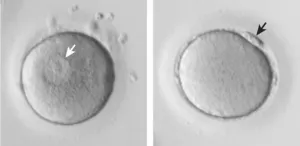(Press-News.org) Researchers at the National Food Institute have come up with a solution that can help combat both food loss and food waste: They have generated a natural lactic acid bacterium, which secretes the antimicrobial peptide nisin, when grown on dairy waste.
Nisin is a food-grade preservative, which can extend the shelf life of foods, and thus can be used to reduce food waste. The discovery also makes it possible to better utilize the large quantities of whey generated when cheese is made.
Nisin is approved for use in a number of foods, where it can prevent the growth of certain spoilage microorganisms as well as microorganisms that make consumers sick. It can for instance inhibit spore germination in canned soups and prevent late blowing in cheeses—without affecting its flavour.
In theory, nisin could be added to fresh milk to extend its shelf life. However, different countries have different rules stating what types of products nisin may be added to and in which amounts.
Extra step towards better utilization of whey
Many dairies are already turning a profit by extracting protein and lactose from the many tons of whey they generate, which they use in e.g. infant formula and sports nutrition. What is left behind can still be used to produce nisin.
In addition to ensuring better resource utilization, there may be a financial gain from producing nisin: Most commercially available nisin products contain 2.5% nisin and cost approximately 40 euro per kilogram.
Read more
The work related to isolating the nisin secreting lactic acid bacteria has been described in further detail in a scientific article in the Journal of Agricultural and Food Chemistry: Efficient Production of Nisin A from Low-Value Dairy Side Streams Using a Nonengineered Dairy Lactococcus lactis Strain with Low Lactate Dehydrogenase Activity.
A special topic portal on the National Food Institute’s website showcases some of the many ways in which the institute works to create sustainable technological solutions in the area of food. Read e.g. about projects that transform side streams into new ingredients and foods.
Lactic acid bacteria can extend the shelf life of foods
2021-04-28
ELSE PRESS RELEASES FROM THIS DATE:
Dead lithium: The culprit of low Coulombic efficiency with LIBs
2021-04-28
The target of carbon-neutral and net-zero emissions is the development and utilization of renewable energy. High-energy-density energy storage systems are critical technologies for the integration of renewable energy.
Li metal is highly recognized as a promising alternative anode for next-generation rechargeable batteries due to its high theoretical capacity of 3860 mAh g-1 and ultralow electrode potential of -3.04 V compared to the standard hydrogen electrode.
However, Li metal batteries' (LMBs) main issue is their low Coulombic efficiency (CE), which limits batteries' cycle life. The low CE in LMBs occurs ...
Ageing impairs critical final egg maturation stage
2021-04-28
Age may adversely affect women's fertility by impairing levels of RNA molecules which in turn alter the function of genes involved in key biological pathways during the final maturation stage of a human egg cell, according to the findings of a new study published today in the journal Aging Cell.
Researchers from the Centre for Genomic Regulation (CRG), the Centro Nacional de Análisis Genómico (CNAG-CRG) and Clínica Eugin sequenced the RNA molecules, also known as the transcriptome, within oocytes to understand which genes are affected in their activity by age. They used single-cell sequencing to analyse the transcriptome of 72 individual oocytes ...
Many children with cardiomyopathy have a genetic mutation but few are screened
2021-04-28
BUFFALO, N.Y. -- A national, University at Buffalo-led study on genes in pediatric cardiomyopathy demonstrates strong evidence for routine genetic screening in children with the disease. The study, published April 28 in the Journal of the American Heart Association, revealed wide variation in screening, with some centers conducting routine genetic testing and others conducting none.
Conducted at 14 centers, the National Institutes of Health-funded study of 152 children with cardiomyopathy found that only half had undergone genetic screening. Of those who hadn't undergone screening, 21% were found to have a genetic cause for the ...
Scientists' discovery of blood clotting mechanism could lead to new antithrombotic drugs
2021-04-28
Under normal, healthy circulatory conditions, the von Willebrand Factor (vWF) keeps to itself. The large and mysterious glycoprotein moves through the blood, balled up tightly, its reaction sites unexposed. But when significant bleeding occurs, it springs into action, initiating the clotting process.
When it works properly, vWF helps stop bleeding and saves lives. However, according to the Centers for Disease Control and Prevention (CDC), about 60,000 to 100,000 Americans die each year from thrombosis, a disorder characterized by too much clotting. Blood clots can trigger a stroke or heart attack.
According ...
Using microbes to remove microplastics from the environment
2021-04-28
Today at the Microbiology Society's Annual Conference, Yang Liu, researcher at Hong Kong Polytechnic University, will discuss a new technique to trap and recover microplastics.
The method uses bacterial biofilms, a sticky substance created by micro-organisms, to trap microplastic particles. The biofilm is then processed and dispersed, releasing the microplastic particles for processing and recycling.
Liu and colleagues used the bacterium Pseudomonas aeruginosa to capture microplastics in a bioreactor. This species of bacteria is found in all environments and has previously been shown to colonise microplastics in the environment.
P. aeruginosa biofilms ...
Study shows both parents and peers play a role in greater alcohol use among adolescents who experience early puberty
2021-04-28
Research shows that children who experience puberty earlier than their peers are more likely to begin drinking alcohol at a young age and early alcohol exposure is also known to be related to alcohol dependence later in life. Specifically, adolescents who mature early are two to three times more likely to drink than other youth. In addition, early maturing girls are two to three times more likely to drink until intoxication and three times as likely to have an alcohol use disorder. A new study examined why early developing 14-year-old adolescents are more likely to drink alcohol compared to those whose pubertal development is on-time or late. The findings show these adolescents are more likely to have ...
Policies designed to protect public health from fracking may be ineffective in practice
2021-04-28
Frequent use of exemptions may undermine public health protections of oil and gas setback policies, according to a new study led by researchers at the research institute PSE Healthy Energy, Harvard University, and Nicholas Institute for Environmental Solutions at Duke University. The study, published April 28, 2021 in Energy Policy, is the first to assess the effectiveness of distance-based setback regulations for unconventional natural gas development (UNGD) or "fracking."
"Setback regulations are commonly employed to protect public health, so we wanted to test if they're effective in practice," said lead author Drew Michanowicz, DrPH, ...
GeneSight Mental Health Monitor shows misunderstanding of depression and treatment
2021-04-28
In a new nationwide poll, the GeneSight® Mental Health Monitor found that 83% of people with depression agree that life would be easier if others could understand their depression. Yet, most people who have not experienced depression may not be able to understand the challenges, including its treatment.
"Depression is one of the most misunderstood disorders. When people misinterpret patients with depression as 'lazy' or 'dramatic,' they are vastly underestimating and misunderstanding the debilitating symptoms of major depressive disorder," said Mark Pollack, M.D., chief medical officer for the GeneSight test at Myriad ...
Parents more lenient about alcohol with teens who experience puberty early
2021-04-28
UNIVERSITY PARK, Pa. -- Parents of teens who went through puberty early may be more lenient when it comes to letting them consume alcohol, according to a new Penn State study. But the researchers said that even if adolescents appear more mature, drinking alcohol is still not safe for them.
Rebecca Bucci, a PhD candidate in criminology at Penn State, said the study -- published today (April 28) in Child Development -- aimed to discover why adolescents who go through puberty early are more likely than their peers to drink alcohol.
"A surprising proportion of parents in our study allowed their early-developing children to drink alcohol at the age of 14 -- in fact, ...
Can genetics predict bothersome hot flashes?
2021-04-28
CLEVELAND, Ohio (April 28, 2021)--Hot flashes are a hallmark of the menopause transition. Yet, they don't strike with the same frequency or severity for all women. A new study suggests that some of the same genetic factors that affect a woman's reproductive life cycle may also help predict her likelihood of having bothersome hot flashes. Study results are published online today in Menopause, the journal of The North American Menopause Society (NAMS).
Despite multiple studies on the subject, questions still remain as to why some women are more affected than others by hot flashes and night sweats during the menopause transition. Genetics may be one reason, ...

